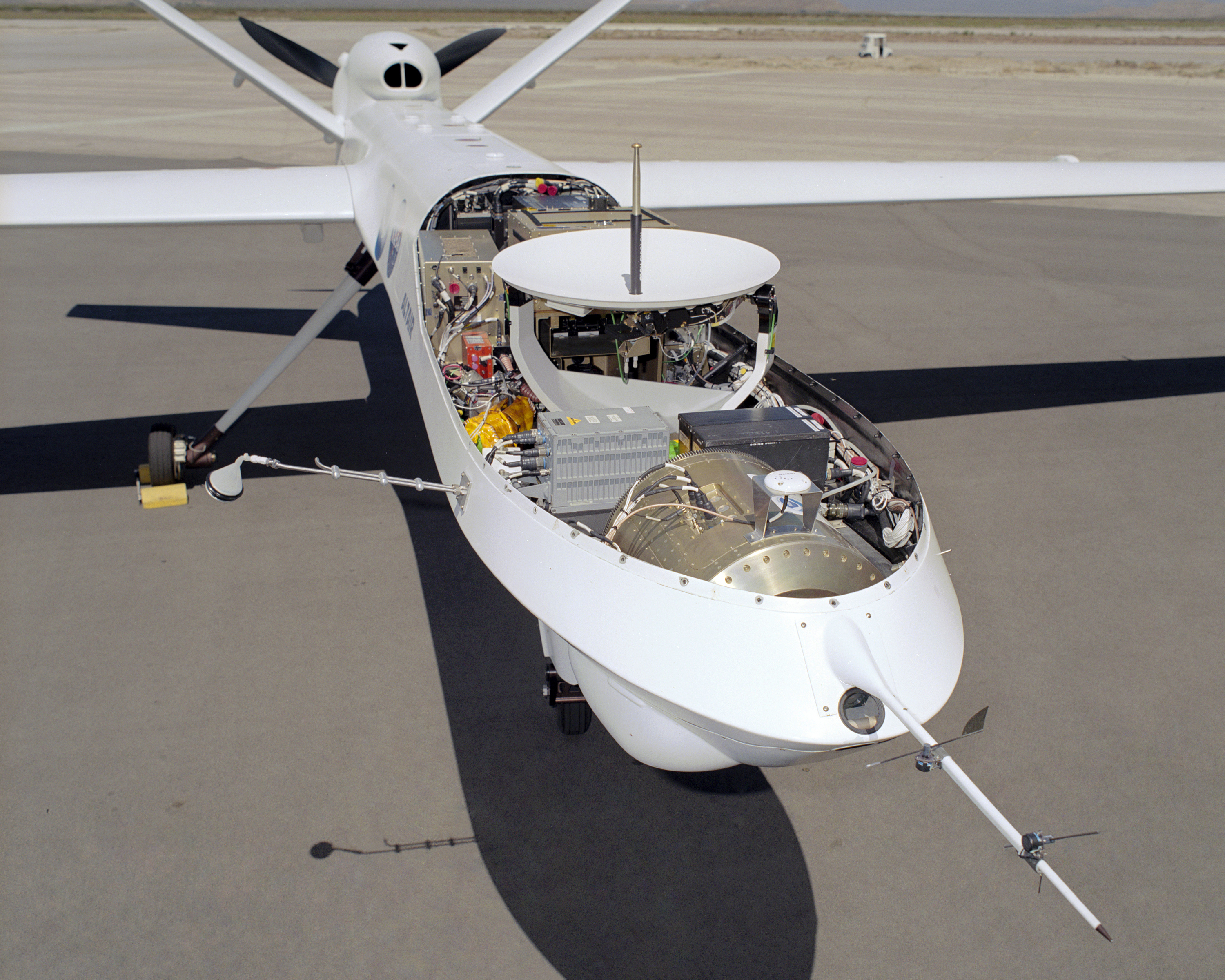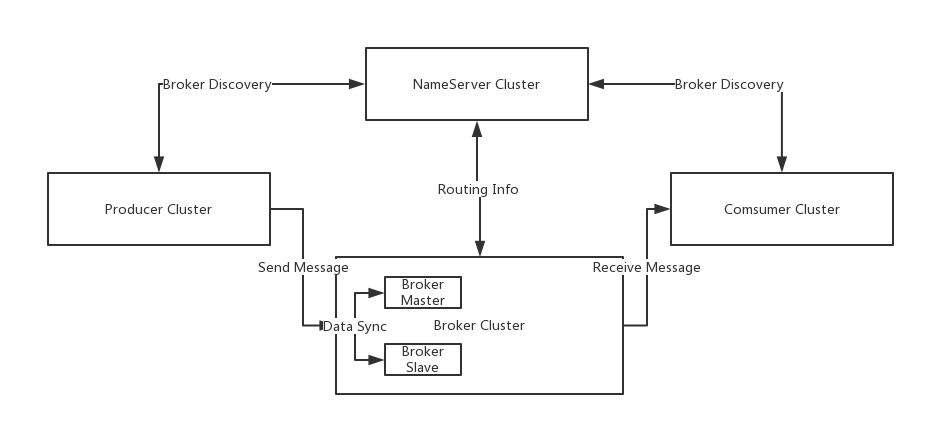|
General Atomics MQ-9 Reaper
The General Atomics MQ-9 Reaper (sometimes called Predator B) is an unmanned aerial vehicle (UAV) capable of remotely controlled or autonomous flight operations developed by General Atomics Aeronautical Systems (GA-ASI) primarily for the United States Air Force (USAF). The MQ-9 and other UAVs are referred to as Remotely Piloted Vehicles/Aircraft (RPV/RPA) by the USAF to indicate their human ground controllers. The MQ-9 is the first hunter-killer UAV designed for long-endurance, high-altitude surveillance. In 2006, the then– Chief of Staff of the United States Air Force General T. Michael Moseley said: "We've moved from using UAVs primarily in intelligence, surveillance, and reconnaissance roles before Operation Iraqi Freedom, to a true hunter-killer role with the Reaper." The MQ-9 is a larger, heavier, and more capable aircraft than the earlier General Atomics MQ-1 Predator; it can be controlled by the same ground systems used to control MQ-1s. The Reaper has a 950- sh ... [...More Info...] [...Related Items...] OR: [Wikipedia] [Google] [Baidu] |
General Atomics MQ-1 Predator
The General Atomics MQ-1 Predator (often referred to as the predator drone) is an American remotely piloted aircraft (RPA) built by General Atomics that was used primarily by the United States Air Force (USAF) and Central Intelligence Agency (CIA). Conceived in the early 1990s for aerial reconnaissance and forward observation roles, the Predator carries cameras and other sensors. It was modified and upgraded to carry and fire two AGM-114 Hellfire missiles or other munitions. The aircraft entered service in 1995, and saw combat in the War in Afghanistan (2001–present), war in Afghanistan, War in North-West Pakistan, Pakistan, the NATO intervention in Bosnia, 1999 NATO bombing of Yugoslavia, the Iraq War, Yemen, the 2011 Libyan civil war, the 2014 US-Coalition intervention in Syria, 2014 intervention in Syria, and Somalia. The USAF describes the Predator as a "Tier II" MALE UAS (medium-altitude, long-endurance unmanned aircraft system). The UAS consists of four aircraft or "air ... [...More Info...] [...Related Items...] OR: [Wikipedia] [Google] [Baidu] |
IBM MQ
IBM MQ is a family of message-oriented middleware products that IBM launched in December 1993. It was originally called MQSeries, and was renamed ''WebSphere MQ'' in 2002 to join the suite of WebSphere products. In April 2014, it was renamed ''IBM MQ''. The products that are included in the MQ family are IBM MQ, IBM MQ Advanced, IBM MQ Appliance, IBM MQ for z/OS, and IBM MQ on IBM Cloud. IBM MQ also has containerised deployment options. MQ allows independent and potentially non-concurrent applications on a distributed system to securely communicate with each other, using messages. MQ is available on a large number of platforms (both IBM and non-IBM), including z/OS ( mainframe), IBM i, Transaction Processing Facility, UNIX (AIX, HP-UX, Solaris), HP NonStop, OpenVMS, Linux, and Microsoft Windows. MQ Components The core components of MQ are: * Message: Messages are collections of binary or character (for instance ASCII or EBCDIC) data that have some meaning to a participating ... [...More Info...] [...Related Items...] OR: [Wikipedia] [Google] [Baidu] |
Northrop Grumman MQ-8 Fire Scout
The Northrop Grumman MQ-8 Fire Scout is an unmanned autonomous helicopter developed by Northrop Grumman for use by the United States Armed Forces. The Fire Scout is designed to provide reconnaissance, situational awareness, aerial fire support and precision targeting support for ground, air and sea forces. The initial RQ-8A version was based on the Schweizer 330, while the enhanced MQ-8B was derived from the Schweizer 333. The larger MQ-8C Fire Scout variant is based on the Bell 407. As of February 2018, 23 MQ-8B variants were in service with the U.S. Navy. Design and development RQ-8A As the US Navy was withdrawing its RQ-2 Pioneers from service, it began to seek a second generation UAV. The Navy requirement specified a vertical takeoff & landing (VTOL) aircraft, with a payload capacity of 90 kg (200 lb), a range of 125 miles (200 km), an endurance on station of three hours at an altitude of , and the ability to land on a ship in a wind. The UAV was to fly 19 ... [...More Info...] [...Related Items...] OR: [Wikipedia] [Google] [Baidu] |
Northrop Grumman MQ-8C Fire Scout
The Northrop Grumman MQ-8C Fire Scout (known as the Fire-X during development) is an unmanned helicopter developed by Northrop Grumman for use by the United States Navy. The MQ-8C also has autonomous take-off and landing capability. It is designed to provide reconnaissance, situational awareness, aerial fire support and precision targeting support for ground, air and sea forces. The MQ-8C airframe is based on the Bell 407, while the avionics and other systems are developed from those used on the MQ-8B Fire Scout. It first flew in October 2013$1726.1m remains to be spent on procurement with 96 airframes to be acquired which will all be MQ-8C, the total budget mixes in cheaper MQ-8B's. and achieved initial operational capability on 28 June 2019. Design and development On 3 May 2010, Northrop Grumman announced plans to fly a Bell 407 helicopter modified with autonomous controls from the MQ-8B. Named Fire-X, it was to demonstrate an unmanned cargo resupply capability to the US N ... [...More Info...] [...Related Items...] OR: [Wikipedia] [Google] [Baidu] |
Northrop Grumman MQ-4C Triton
The Northrop Grumman MQ-4C Triton is an American high-altitude long endurance unmanned aerial vehicle (UAV) under development for the United States Navy as a surveillance aircraft. Together with its associated ground control station, it is an unmanned aircraft system (UAS). Developed under the ''Broad Area Maritime Surveillance'' (BAMS) program, the system is intended to provide real-time intelligence, surveillance and reconnaissance missions (ISR) over vast ocean and coastal regions, continuous maritime surveillance, conduct search and rescue missions, and to complement the Boeing P-8 Poseidon maritime patrol aircraft. Triton builds on elements of the RQ-4 Global Hawk; changes include reinforcements to the air frame and wing, de-icing systems, and lightning protection systems. These capabilities allow the aircraft to descend through cloud layers to gain a closer view of ships and other targets at sea when needed. The sensor suites allow ships to be tracked by gathering inform ... [...More Info...] [...Related Items...] OR: [Wikipedia] [Google] [Baidu] |
Boeing MQ-25 Stingray
The Boeing MQ-25 Stingray is an aerial refueling drone that resulted from the Carrier-Based Aerial-Refueling System (CBARS) program, which grew out of the earlier Unmanned Carrier-Launched Airborne Surveillance and Strike (UCLASS) program. The MQ-25 first flew on 19 September 2019. Development Background The United States Navy began its efforts to develop an aircraft carrier-based UAV in 2006. The original UCLASS concept was for a stealthy strike platform capable of penetrating enemy air defenses. In 2012, lethality and strike requirements were diluted in order to create an intelligence, surveillance and reconnaissance (ISR)-oriented aircraft that could be developed quickly to conduct low-intensity counter-terrorism missions. On 1 February 2016, after delays over whether the UCLASS would specialize in strike or ISR roles, it was reported that significant priority would be given to producing a Super Hornet-sized carrier-based aerial refueling tanker as the Carrier-Based Aerial ... [...More Info...] [...Related Items...] OR: [Wikipedia] [Google] [Baidu] |
Apache ActiveMQ
Apache ActiveMQ is an open source message broker written in Java together with a full Java Message Service (JMS) client. It provides "Enterprise Features" which in this case means fostering the communication from more than one client or server. Supported clients include Java via JMS 1.1 as well as several other "cross language" clients. The communication is managed with features such as computer clustering and ability to use any database as a JMS persistence provider besides virtual memory, cache, and journal persistency. There's another broker under the ActiveMQ umbrella code-named ''Artemis''. It is based on the HornetQ code-base which was donated from the JBoss community to the Apache ActiveMQ community in 2015. Artemis is the "next generation" broker from ActiveMQ and will ultimately become the next major version of ActiveMQ. History The ActiveMQ project was originally created by its founders from LogicBlaze in 2004, as an open source message broker, hosted by CodeHaus. The c ... [...More Info...] [...Related Items...] OR: [Wikipedia] [Google] [Baidu] |
General Atomics MQ-1C Gray Eagle
The General Atomics MQ-1C Gray Eagle (previously the Warrior; also called Sky Warrior and ERMP or Extended-Range Multi-Purpose) is a medium-altitude, long-endurance (MALE) unmanned aircraft system (UAS). It was developed by General Atomics Aeronautical Systems (GA-ASI) for the United States Army as an upgrade of the General Atomics MQ-1 Predator. Development The U.S. Army initiated the Extended-Range Multi-Purpose UAV competition in 2002, with the winning aircraft due to replace the RQ-5 Hunter. Two aircraft were entered, the IAI/Northrop Grumman Hunter II, and the Warrior. In August 2005, the Army announced the Warrior to be the winner and awarded a $214 million contract for system development and demonstration. The Army intended to procure eleven Warrior systems, each of these units having twelve UAVs and five ground control stations. With an expected total program cost of $1 billion, the aircraft was to enter service in 2009. The Army announced on 3 September 2010 that the ... [...More Info...] [...Related Items...] OR: [Wikipedia] [Google] [Baidu] |
Apache RocketMQ
RocketMQ is a distributed messaging and streaming platform with low latency, high performance and reliability, trillion-level capacity and flexible scalability. It is the third generation distributed messaging middleware open sourced by Alibaba Group, Alibaba in 2012. On November 21, 2016, Alibaba donated RocketMQ to Apache Software Foundation, the Apache Software Foundation. Next year, on February 20, the Apache Software Foundation announced Apache RocketMQ as a Top-Level Project. History The development of RocketMQ can be divided into three stages. The first generation uses the push mode in data transportation, and relational database in data storage. It shows low latency in message delivery and meets the command of a typical E-commerce platform with distributed transactions. The second generation uses the pull mode in data transportation, and file system in data storage. It paid more attention to stability and reliability, and shows a comparable performance to the first gen ... [...More Info...] [...Related Items...] OR: [Wikipedia] [Google] [Baidu] |
Message Queue
In computer science, message queues and mailboxes are software-engineering components typically used for inter-process communication (IPC), or for inter- thread communication within the same process. They use a queue for messaging – the passing of control or of content. Group communication systems provide similar kinds of functionality. The message queue paradigm is a sibling of the publisher/subscriber pattern, and is typically one part of a larger message-oriented middleware system. Most messaging systems support both the publisher/subscriber and message queue models in their API, e.g. Java Message Service (JMS). Remit and ownership Message queues implement an asynchronous communication pattern between two or more processes/threads whereby the sending and receiving party do not need to interact with the message queue at the same time. Messages placed onto the queue are stored until the recipient retrieves them. Message queues have implicit or explicit limits on the ... [...More Info...] [...Related Items...] OR: [Wikipedia] [Google] [Baidu] |
MTC MQ-17 SpyHawk
The XMQ-17A ("SpyHawk") is an unmanned aerial vehicle built and developed by MTC Technologies which was intended to be used by the US Marine Corps in order to fulfill a need for an unmanned aerial reconnaissance capability at division level, or "Tier II". Launched from a trailer-mounted pneumatic launcher, the aircraft is powered by a single Honda GX-57 gasoline-fueled piston engine. The SpyHawk purchase was canceled in January 2008, after MTC Technologies was purchased by BAE Systems BAE Systems plc (BAE) is a British multinational arms, security, and aerospace company based in London, England. It is the largest defence contractor in Europe, and ranked the seventh-largest in the world based on applicable 2021 revenues. .... Specifications (XMQ-17A) References Unmanned aerial vehicles of the United States 2000s United States military reconnaissance aircraft Single-engined tractor aircraft Cancelled military aircraft projects of the United States {{aero-2 ... [...More Info...] [...Related Items...] OR: [Wikipedia] [Google] [Baidu] |






